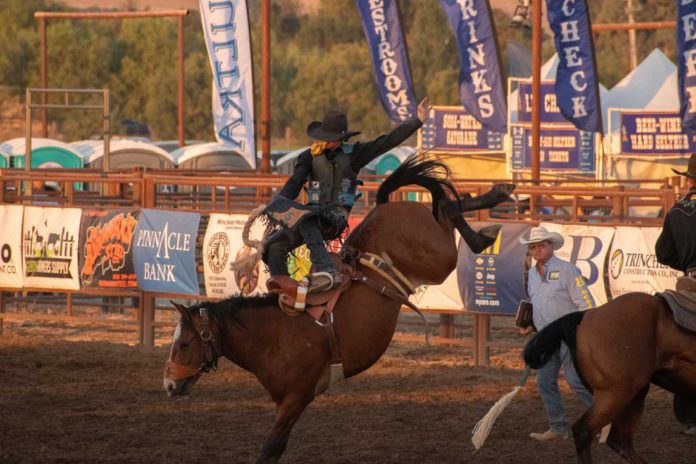
The death of a bucking horse that suffered a broken neck during a performance at the Gilroy Rodeo Aug. 8 has raised questions about animal safety protocols and injury reporting requirements.
The mare, known as +H6 Cow Palace, fell while bucking and broke her neck, according to multiple sources. Despite initial social media posts suggesting veterinarians were providing care, rodeo officials later claimed that no veterinary treatment was possible.
“Its death was instantaneous,” Rodeo President Erik Martin wrote in email correspondence with animal welfare group Action for Animals. “There was a veterinarian there at the time of the incident, but no treatment was able to be rendered, only confirmation of death.”
The incident has drawn scrutiny from animal rights advocates who point to discrepancies between the rodeo’s initial public statements and later private communications about the severity of the accident.
The Gilroy Rodeo’s initial Facebook post stated, “Veterinarians are providing expert care” and thanked “animal welfare partners for their swift and compassionate response in ensuring the horse received immediate care.”
An eyewitness to the incident disputes the claim that the horse’s death was instantaneous, describing seeing rodeo officials and a veterinarian respond quickly to tend to the horse.
The horse “definitely received vet care,” said the eyewitness who preferred to remain anonymous. “That was evident. What happened after leaving the arena I don’t know.”
“A vet and truck with trailer came out very fast to tend to the horse,” they said. “They lifted it into the trailer and left the arena. The rodeo staff were incredibly attentive and couldn’t have done more. They were supportive of the horse, rider and those watching. I was impressed on how they handled it.”
Eric Mills, founder of Action for Animals and a longtime critic of rodeo events, said the incident highlights ongoing animal welfare concerns in the sport.
“Rodeo is condemned for its inherent cruelty by nearly every animal welfare organization on the planet,” Mills said. He noted that similar events led to the outlawing of rodeo in the United Kingdom in 1934.
California Penal Code 596.7, which Mills helped pass in 1999, requires that injured rodeo animals receive immediate veterinary examination and treatment. The law also mandates that attending veterinarians submit injury reports to the Veterinary Medical Board within 48 hours of a rodeo’s conclusion.
According to the VMB, no report was filed within the 48 hour required window, with rodeo authorities claiming that because +H6 Cow Palace died instantly, no treatment was possible and therefore no injury report is required by state law.
Section 596.7 violations can include fines of $500-$2,000 for first infractions and $1,500-$5,000 for second or subsequent infractions.
The deceased mare was owned by Lone Oak Western Productions, a family-operated company run by Emily and Elliot French that specializes in bucking horse breeding, rodeo production and film work.
In a social media statement, the company described the horse as “more than just a valuable athlete to our program” and noted that her filly would be named in her honor.
The company has not responded to requests for comment about the incident.
The three-day rodeo, which sold out, continued after the Friday night incident. Arena Manager Stacie Roberts emphasized that such incidents are “extremely rare” while acknowledging the inherent risks involved in rodeo.
“We share in the sadness of the animal’s owner, our staff, and the community,” she said. “We remain committed to the responsible care of all animals involved in our events.”
The incident has reignited broader debates about the ethics of rodeo as entertainment. Critics argue that rodeo animals are subjected to stress-inducing practices including the use of bucking straps, electric prods and confinement that can lead to injuries.
“Rodeo tries to pass itself off as a sport—it is not,” Mills said. “Sport, by definition, requires equally-matched, willing contestants. Rodeo does not qualify.”
While injuries to horses are relatively rare at rodeo events, injuries to other animals, especially calves, are significantly more common, according to Mills, though these injuries typically go unreported.
“Calves are injured every time they’re roped or thrown,” he said. “And these are baby animals … quite often unweaned or weaned early, and under a lot of stress being separated from their mothers.”
Supporters counter that modern rodeo prioritizes animal welfare and that accidents, while tragic, are rare occurrences in a sport with deep cultural roots in the region’s agricultural heritage.
As the rodeo community processes this latest incident, questions remain about whether current safety protocols are adequate to protect the animal athletes that are central to the sport’s appeal and tradition.















Thank you very much for this sensible article about the inhumanity of rodeo. I was disgusted by the original article that referred to this poor horse as having “passed away.” Every effort was made to sugar coat this horror. She died for no reason other than in the service of this macho “sport.” She had no choice. Neither do the babies that are dragged to the ground and bruised or worse.
I hope she did not die in vane, this beautiful creature. Let this be a wake up call to participants and spectators alike. Spectators have to power to abolish this abomination. Stop attending.
To: Gilroy Dispatch
The last sentence of your article refers to animals in the rodeo as “animal athletes”. That term is incorrect, as the animals are not participating willingly. Nor are they competing; rather, they are slaves who are forced to perform dangerous actions, whatever their masters wish, by the application of pain and fear.
Letters email. ed****@************ch.com
California state rodeo law, Penal Code 596.7, enacted in 2000, requires–in part–that rodeo animal injury reports be submitted the State Veterinary Medical Board. These reports are Public Record, free for the asking, EMAIL – en*************@****ca.gov
Anyone who attends a rodeo is supporting cruelty to animals.
It is as simple as that. The fear and injuries animals experience in rodeos
is common knowledge and has been observed, written about, and documented
for decades.
Individuals who enjoy watching this abuse need to question themselves as to
why they experience pleasure watching animals suffer.
Rodeo is a classic example of the sheer lengths that some will go to in justifying animal abuse while in pursuit of “fun” — and especially — profit. The buckaroos who run these horror shows hijack words and phrases like “heritage” and “ranching culture” and the “American way of life” to sell tickets. And the uninformed among us (and they are numerous) are only too happy to be hoodwinked into buying them. Rodeo, like most everything else in this country, is all about money, and the misery and death of the hapless animals involved barely get a passing thought. It’s just shameful.
A FEW PERTINENT QUOTES:
“If ever there were a completely gratuitous abuse of animals, and often baby animals at that, all done for the sheer thrill and bravado of it, it is rodeo.” (–Matthew Scully, “DOMINION: The Power of Man, the Suffering of Animals, and the Call to Mercy” (2002). Scully is a former speechwriter for Pres. G.W. Bush.)
“Do I think it hurts the calf? Sure I do. I’m not stupid.” (–Keith Martin, CEO, Professional Rodeo Cowboys Association. In the February 6, 2000 SAN ANTONIO EXPRESS-NEWS)
“I keep 30 head of cattle around for practice, at $200 a head. You can cripple three or four in an afternoon.” (–Dr. T.K. Hardy, a Texas veterinarian and sometime steer roper, quoted in NEWSWEEK, 10/2/72)
“Do animals feel fear? Nyaah, they don’t feel fear. They’re an ANIMAL!” (–Russ Fields, rancher and chair, Rowell Ranch Rodeo Committee, in a 5/19/18 KGO-TV Channel 7 news segment, San Francisco)
“If it gets to the point where people think rodeo is inhumane or cruel, they quit coming, and then we’re out of business.” (–Tom Hirsig, CEO, Cheyenne Frontier Days Rodeo, in the July 27, 2018 WYOMING TRIBUNE EAGLE)
Read more at: https://www.montrealgazette.com/opinion/op-eds/article1063373.html#storylink=cpy
I, also, was disgusted by the original article’s description of +H6 Cow Palace “passing away.” Writers use “passing away” to minimize upset and soften the harshness of the word “die” There was nothing gentle about this horse losing her life. She died a violent death.
When will rodeo attenders wake up to what Rodeo really is? The action of taking control of other people or animals in a forceful way, and the quality of liking to do this. It is cruel, ugly, and ignorant. You are only entertaining your need for dominance. Go play baseball or learn to ski. We (people and animals) are sick of you needing to have fun at the expense of innocent and non-compliant animals.
“Deep Cultural Roots” is not a defense of what should be felony acts. Owners of dogs or roosters used for illegal fighting tried and failed to justify their activities as “having deep cultural roots.” Both are now completely banned in the U.S with dog fighting being a felony.
Deep cultural roots, such as slavery, brutal public punishments, barbaric burning-at-the stake punishments, and more, are all banned. Certainly, as the saying goes, “We’ve come a long way, baby.” However, rodeo remains one of the most egregious animal-abuse and cruelty activities left to be banned in the U.S. It is not even close to being a “sport” for any of its animal victims nor a cultural event. Its beginning included Wild West shows that were exaggerated depictions of a cowboy’s life, and is now banned in many areas.
First: Rodeo was never a part of “agricultural heritage.” No rancher would ever subject valuable livestock to potential injuries or risk death since they need to be healthy for market profits. If ranchers do allow potential rodeo contestants to “practice” on their livestock, the animals (especially calves) are usually too small, sick, or already injured and going to be killed rather than sent to market. At least that’s the claim of one rancher who held clandestine rodeo practice sessions at his facility.
Second: “Current safety protocols” for animals either do not exist or are not enforced. The rodeo “show” works only if the rodeo animal victim is in a state of fear, pain, or high stress.
Before the event or gate is opened, so called “animal athletes” have a “Bucking Strap” (aka, Flank Strap) wrapped around their tender flank area that is jerked as tight as possible as the gate opens to create a “flight response” to its extreme distress.
Additionally, while rodeo promoters have stated their animals “love to buck,” abusive spurs are used to cause even more pain as are other techniques, such as ear and tail twisting. Meanwhile, rodeo “cowboys” conveniently sit on chute rails that visually block whatever else is being inflicted on rodeo stock.
Worst, electric prods, electrical shocking or “hotshots” are often banned UNLESS the animal stalls at the opening gate. How does it possibly make sense to shock any animal who is frozen in fear? Not only is this shocking ban not enforced, one national nonprofit has video proof of hand-held hotshots being used repeatedly on animals just as the chute gate opens.
Last: Rodeo promoters claim that none of these activities create pain, suffering, or injuries to animals, but video facts tell a different story. If their denials of cruelty are true, then in a good faith effort, why not simply ban any of those elements of torture? Rodeo will never let go of its cruel need to willingly inflict pain because they know that in his/her natural state, horses won’t buck as wildly for so long, and for sure won’t buck themselves to death as the mare did in her rodeo-inflicted distress.
Marilyn Jasper, Chair, Public Interest Coalition
Pu*************@**ve.com
Thank you all for pointing out this needless cruelty of animals for sport! This is not a sport as these defenseless animals have no say in being subject to this cruel behavior!
There is so much inherent and obvious cruelty in rodeo and yet year after year, decade after decade it continues. What will it take to finally wipe this blight from our state, our country, and the world?